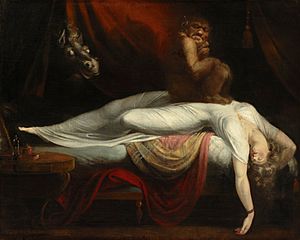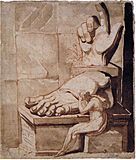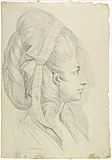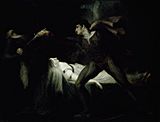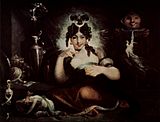Henry Fuseli facts for kids
Quick facts for kids
Henry Fuseli
RA
|
|
|---|---|
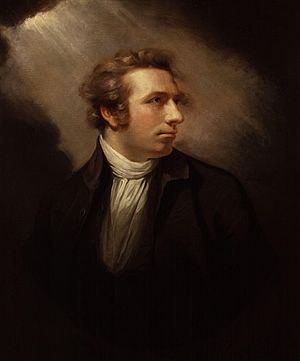
Henry Fuseli, 1778. Portrait by James Northcote.
|
|
| Born |
Johann Heinrich Füssli
7 February 1741 Zürich, Switzerland
|
| Died | 17 April 1825 (aged 84) Putney Hill, London, England
|
| Known for | Painting, draughtsmanship |
|
Notable work
|
The Nightmare |
| Movement | Romanticism |
| Spouse(s) |
Sophia Rawlins
(m. 1788) |
Henry Fuseli (born Johann Heinrich Füssli; 7 February 1741 – 17 April 1825) was a Swiss painter and artist. He also wrote about art. He spent most of his life in Britain. Many of his artworks show supernatural events or dreams, like his famous painting The Nightmare.
Fuseli created paintings for John Boydell's Shakespeare Gallery. He also made his own "Milton Gallery." He worked as a Professor of Painting and a Keeper at the Royal Academy. His unique style greatly influenced younger British artists, including William Blake.
Contents
About Henry Fuseli
Henry Fuseli was born in Zürich, Switzerland. He was the second of 18 children. His father, Johann Caspar Füssli, was a painter of portraits and landscapes. He also wrote books about painters.
Fuseli's father wanted him to become a church minister. So, Henry went to the Caroline college in Zürich. There, he received a classical education. One of his schoolmates was Johann Kaspar Lavater, who became a very close friend.
Early Life and Travel
After becoming a minister in 1761, Fuseli had to leave Switzerland. He had helped his friend Lavater expose a dishonest judge. The judge's powerful family wanted revenge.
Fuseli traveled through Germany. In 1765, he visited England. He earned money by writing different things. Eventually, he met Sir Joshua Reynolds, a famous painter. Fuseli showed Reynolds his drawings. Reynolds advised him to focus only on art.
In 1770, Fuseli went to Italy to study art. He stayed there until 1778. While in Italy, he changed his name from Füssli to Fuseli. This new name sounded more Italian.
Return to Britain and Royal Academy
In early 1779, Fuseli returned to Britain, stopping in Zürich on the way. In London, he had a job waiting for him. Alderman Boydell asked him to paint for his Shakespeare Gallery. Fuseli painted several pieces for Boydell. He also helped publish an English version of Lavater's book on physiognomy (the study of faces).
In 1788, Fuseli married Sophia Rawlins, who had been one of his models. Soon after, he became a member of the Royal Academy. In 1790, he became a full academician. His special artwork for this honor was Thor Battering the Midgard Serpent.
In 1799, Fuseli became a professor of painting at the Royal Academy. Four years later, he became the Keeper of the Academy. He gave up his professorship for a short time but started teaching again in 1810. He held both jobs until he died.
Milton Gallery
In 1799, Fuseli showed a series of paintings based on the works of John Milton. He hoped to create a "Milton Gallery" similar to Boydell's Shakespeare Gallery. There were 47 Milton paintings, many of them very large. He completed them over nine years. However, the exhibition was not successful and closed in 1800.
Later, in 1817, a famous Italian sculptor named Antonio Canova visited England. He was very impressed by Fuseli's art. When Canova returned to Rome, he made sure Fuseli was chosen as a member of the Academy of St Luke.
Henry Fuseli's Artworks
As a painter, Fuseli loved to show supernatural themes. He believed that artists should make things a bit exaggerated in important historical paintings. He learned this idea by studying Michelangelo's works and the large marble statues in Rome. He liked to look at these statues in the evening, against a dark sky or lit up by lightning.
Fuseli was known for how he used light and shadow. He didn't arrange his paints neatly like most artists. Instead, he put colors randomly on his palette. He often used dry paint powder, quickly mixing it with oil or other liquids on his brush. He didn't worry about the exact amounts. This might be because he didn't start painting with oil until he was 25 years old.
Fuseli painted more than 200 pictures. But he only showed a few of them to the public. His first painting was Joseph interpreting the Dreams of the Baker and Butler. The painting that first got a lot of attention was The Nightmare, shown in 1782. He painted several versions of this famous work.
Fuseli made about 800 sketches or drawings. These drawings often show great creativity and design. They are sometimes even better than his paintings. In his drawings, he often made human bodies look exaggerated and twisted his figures into unusual poses. He rarely drew people from real life. Instead, he based his art on studying ancient sculptures and Michelangelo's works.
Like other painters of his time, Fuseli could create feelings of terror and wonder in his art.
Henry Fuseli's Writings
In 1788, Fuseli began writing essays and reviews for a magazine called the Analytical Review. He often visited the home of Joseph Johnson, a publisher who was important in British political and intellectual life. Many other thinkers, writers, and artists also gathered there.
Fuseli was very good at French, Italian, English, and German. He could write well in all these languages. However, he preferred to write his thoughts in German. His most important written work was a series of twelve lectures. He gave these lectures at the Royal Academy, starting in 1801.
Influence on Other Artists
Henry Fuseli taught many students who became famous artists. These included David Wilkie, Benjamin Haydon, William Etty, and Edwin Landseer. William Blake, who was 16 years younger than Fuseli, said that Fuseli had influenced his own art. For a while, many English artists copied Fuseli's unique style.
Death
Henry Fuseli had good health for most of his life. He died at the age of 84 at the house of the Countess of Guildford on Putney Hill. He was buried in the crypt of St Paul's Cathedral in London. He was quite wealthy when he passed away.
Gallery
-
Macbeth consulting the Vision of the Armed Head, 1793
Films
- Passion and Obsession: Henry Fuseli, 1741–1825: painter and writer by Gaudenz Meili and Prof. David H. Weinglass, Zurich 1997
See also
 In Spanish: Johann Heinrich Füssli para niños
In Spanish: Johann Heinrich Füssli para niños
- Füssli, Johann Caspar (1706–1782), Swiss portrait painter (Henry Fuseli's father)
- Füssli, Johann Kaspar (1743–1786), Swiss entomologist (Henry Fuseli's brother)


